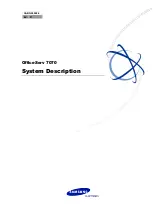
Time mode (day/lunch/break/night) of the preprogrammed tenant is applied to the DID destination and
company greeting number.
PBX
Tenant 1
123-4567
(Company A)
Tenant 3
(Company B)
Trunk Call
Extn. 105
Extn. 102
VPS
(Floating Extn. No. 500)
Intercept
123-2468
Trunk Call
Sends the following information:
·
VM Trunk Group: 1
·
Time mode: Day
Sends the following information:
·
VM Trunk Group: 2
·
Time mode: Night
8.
Caller’s Identification Notification to the VPS
When receiving a trunk call, the PBX sends the caller’s identification number/name to the VPS.
9.
DID Number Notification to the VPS
When receiving a trunk call with a DDI/DID number, the PBX sends the DDI/DID number to the VPS. The
number will be sent to the VPS even if the call reaches the VPS after redirection by, for example, the
Intercept Routing feature.
10.
Status Notification to the VPS
After the call is redirected by the VPS, the PBX sends the status of the redirected extension (e.g., busy)
to the VPS.
11.
Paging by the VPS
The VPS can perform the Paging feature using the recorded message. (
®
12.
Live Call Screening (LCS)
A PT or PS user can monitor his own mailbox while a caller is leaving a message and, if desired, answer
the call by pressing the LCS button. When the caller is leaving a message in the mailbox, monitoring can
be carried out in two ways: each PT user can choose which through personal programming (Live Call
Screening Mode Set). PS users cannot choose the way: only Private mode is available for them.
Hands-free mode:
The user can monitor the call automatically through the built-in speaker.
Private mode:
The user will hear a warning tone. To monitor the call, the user goes off-hook with the
handset, MONITOR button, or SP-PHONE button. However, PS users cannot monitor the call with the
speakerphone.
→
13.
Two-way Recording into the VPS
A PT user can record a conversation into his own mailbox or another mailbox, while talking on the phone.
314
Feature Guide
2.28.3 Voice Mail DPT (Digital) Integration
Summary of Contents for KX-NS500
Page 14: ...14 Feature Guide Table of Contents...
Page 15: ...Section 1 For Your Safety Feature Guide 15...
Page 18: ...18 Feature Guide 1 1 1 For Your Safety...
Page 19: ...Section 2 Call Handling Features Feature Guide 19...
Page 57: ...632 Maximum Number of Agents Feature Guide 57 2 2 2 Incoming Call Distribution Group Features...
Page 107: ...User Manual References 1 2 1 Basic Calling Feature Guide 107 2 5 4 Trunk Call Features...
Page 193: ...User Manual References 1 4 2 Holding a Call Feature Guide 193 2 13 1 Call Hold...
Page 324: ...324 Feature Guide 2 30 2 Outgoing Message OGM...
Page 325: ...Section 3 Unified Messaging System Feature Guide 325...
Page 375: ...Section 4 Network Features Feature Guide 375...
Page 464: ...464 Feature Guide 4 3 6 Network ICD Group...
Page 465: ...Section 5 System Configuration and Administration Features Feature Guide 465...
Page 560: ...560 Feature Guide 5 6 7 PING Confirmation...
Page 561: ...Section 6 Appendix Feature Guide 561...
Page 578: ...578 Feature Guide 6 5 2 PFMPR Software File Version 004 2xxxx...
Page 579: ...Feature Guide 579 Notes...
































